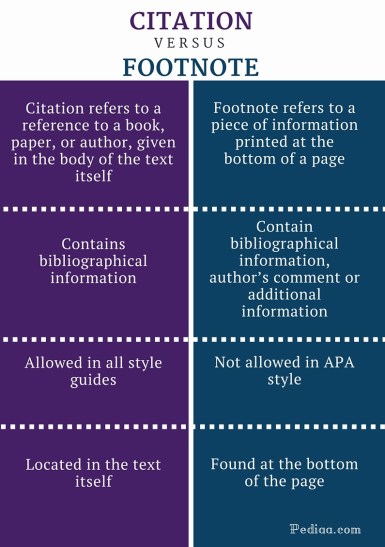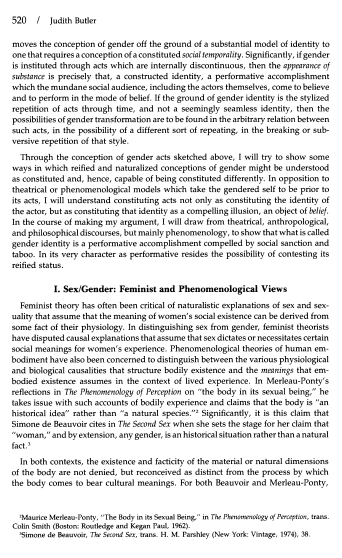主な違い – 引用と脚注の違い
引用
In the standard practice of writing, whenever you are using someone else’s ideas, opinions or findings, etc., you always have to mention the source from where you obtained that information. Using someone else’s ideas and not mentioning the sources is considered an academic theft, which is known as plagiarism. However, the sources also have to be included in your paper in a systematic way; citation and footnotes are two methods of doing this. The main difference between citation and footnote is that citation is generally included in the text itself whereas footnotes are given at the bottom of the page.
引用とは
引用とは、情報の出所を示すものです。
どこからアイデアや情報を得たのか、読者に伝えることができます。
これは、本文中で行われます。
作品に引用を加えるには、さまざまなスタイルガイドがあります。
著者の名前と出版年を記載するのもその方法の一つです。
この方法は、APAスタイルに従います。
民俗学の研究は、ヨーロッパにおけるロマン主義的なナショナリズムの時代に、独立した学問分野として登場し始めた。
という言い方もできる。
Noyes (2012)が言うように、Research into folklore beganerge as an independent discipline during the period of romantic nationalism in Europe(ヨーロッパにおけるロマン主義的民族主義の時代に、民俗学研究は独立した学問として出現し始めた)。
ただし、MLA のレファレンス・スタイルでは、出版年をページ番号に置き換える。
民俗学研究は、ヨーロッパにおけるロマン主義的ナショナリズムの時代に、独立した学問分野として出現し始めた。
Noyes は、Research into folklore began to emerge as an independent discipline during the period of romantic nationalism in Europe(ヨーロッパにおけるロマン主義的ナショナリズムの時代に、民俗学研究は独立した学問として出現し始めた。

脚注とは
脚注とは、ページの下部または脚部にあるものです。
脚注は、書誌情報を示すだけでなく、追加情報や執筆者のコメントを追加することもできます。
特定の事実を他の資料から得た場合、本文中に上付き文字で番号が表示されることがあります。
対応するコメントや情報は、ページの下に表示されます。
例えば、本文はこのようになります。
民俗学は、ヨーロッパにおけるロマン主義的ナショナリズムの時代に、独立した学問として登場した1。
民俗学者は、まず民話を研究してデータを収集し、次に人々にインタビューするなどのフィールドワークを行う。
A corresponding note will be at the end of the page, containing bibliographic information or additional comments. For example, look at the following image. ⇓
⇓
しかし、脚注はすべてのスタイルガイドで認められているわけではありません。
例えばAPAのスタイルガイドでは、脚注や注の使用は推奨されていません。
引用と脚注の違い
定義
引用とは、特に学術的な著作物において、書籍、論文、著者などからの引用や言及を意味します。
脚注とは、ページの下に印刷された情報の一部を指します。
情報の種類
引用は、書誌情報を含みます。
脚注は、書誌情報、著者のコメント、追加情報を含むことができます。
スタイルガイド
引用はすべてのスタイルガイドで可能です。
APAスタイルでは脚注は認められません。
所在地
引用は本文中で行う。
脚注はページの最下部に記載されます。
保存方法
